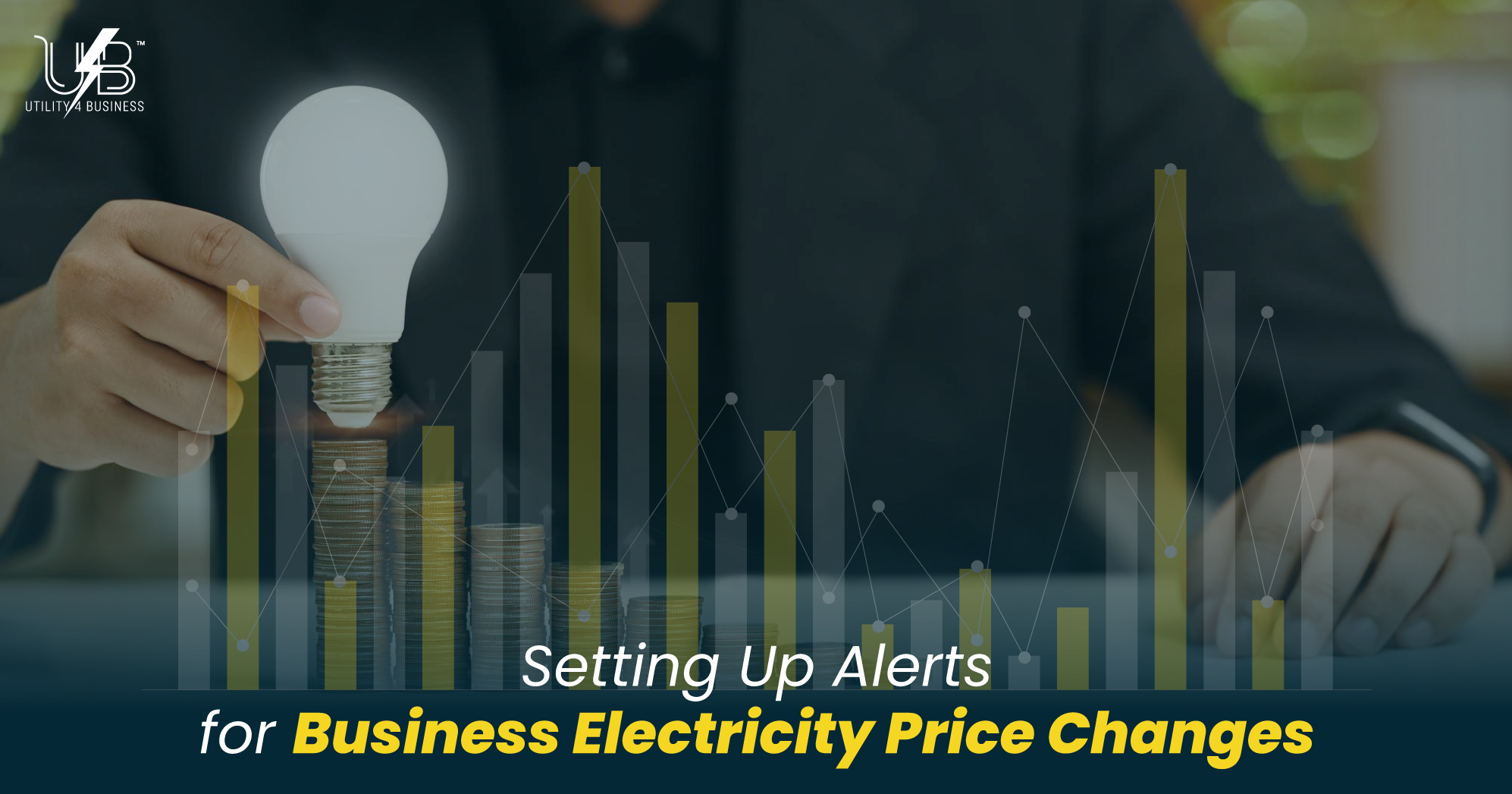Setting Up Alerts for Business Electricity Price Changes
Business Electricity Comparison and Alerts

Setting Up Alerts for Business Electricity Price Changes
Staying ahead of power costs is not luck. It comes from watching the right signals and acting at the right time. Many UK firms renew electricity contracts once a year and then forget about them. Months later, the renewal window sneaks up. Quotes arrive when markets are jumpy. Costs rise for another term. This guide shows how to set up smart alerts, so decisions happen on the best day, not the last day. It also explains how business electricity comparison and its variants, like business electricity price comparison and compare business electricity, fit into an alert-led approach that protects margins.
Why Price Alerts Matter for UK Businesses
Electricity is a controllable cost when leaders use timely data. Alerting makes that practical. Alerts help finance teams plan cash flow. They give operations time to shift usage on costly days. They support procurement in choosing the right moment to fix a rate. Unlike domestic customers, businesses do not sit under a universal price cap. Contracts vary by timing, volume, and strategy. Without alerts, the risk of rolling onto expensive rates grows. With alerts, a firm treats buying power like buying stock: track, signal, act, review.
Know What You’re Actually Tracking
Setting good alerts starts with clear targets. Not all “price changes” mean the same thing for every contract.
Contract Type Shapes the Signal
Fixed contracts lock in unit rates for a set term. Alerts then focus on renewal dates and the period before the contract ends. That is when quotes tend to move the most. Variable or tracker-style products follow the wholesale market more closely. Alerts here watch daily price moves and short notices from the supplier. Flexible or managed strategies buy in blocks. Alerts track thresholds that tell the buyer to add or reduce cover. Whichever contract type applies, link each alert to a decision. If an alert fires, someone must do something with it.
Wholesale Signals, Not Headlines
The wholesale market steers many contract quotes. Day-ahead and month-ahead movements are a useful warning light. Spikes often flow through to business offers, sometimes within days. Alerts that watch these signals help buyers avoid panic when quotes jump. They also help spot value when prices cool. Yet wholesale is only part of the story. Standing charges and network costs sit on top. Build alerts that reflect the business electricity comparison reality: total cost, not just the wholesale curve.
Non-Commodity Costs Still Matter
Delivery, network, and policy costs can shift the final pence per kWh. If alerts only chase wholesale drops, quotes may still look high. Add checks for the total delivered price on quotes, not just the unit rate. This keeps attention on what the business pays, not just what the market does.
Where to Get Price Signals and Alerts
Good alerts do not need fancy tools. They need clean inputs and clear owners.
Supplier and Advisory Updates
Suppliers send renewal notices and may share guidance on usage patterns. Use these as a baseline, but run independent checks as well. For example, log daily or weekly spot checks of market commentary and wholesale summaries. Validate every renewal quote against an internal benchmark range. This creates an audit trail and supports budget planning.
Market Data and Simple Automations
Public data portals and grid updates provide reliable signals. Create daily alerts for day-ahead price changes. Add weekly alerts that summarise the broader market trend. Connect these alerts to email, Teams, or Slack with simple webhooks. Use spreadsheets to store thresholds, dates, and actions. This keeps the system transparent and easy to maintain.
Energy Management Platforms
If a site has sub-metering or half-hourly data, alerts can focus on usage spikes and cost per kWh during peak periods. Operations teams can then move flexible loads away from expensive windows. Tie these operational alerts to procurement alerts. The first reduces the volume that falls into high-cost hours. The second improves the rate paid for the rest.
Step-by-Step: Setting Up Effective Alerts
Strong alerting is a process. Each step builds control and removes guesswork.
Map the Exposure
List every supply point, contract type, start date, end date, and termination rule. Note the meter type and the average monthly kWh. Record standing charges and unit rates. Add a link to the latest bill. This takes an afternoon and pays back every quarter. Once the map exists, alerts can point to the right contract and the right decision owner.
Choose the Data Sources
Pick two or three sources for market signals and stick to them. Daily day-ahead movements suit variable exposure. Weekly wholesale summaries suit fixed-rate renewal planning. Add internal data such as rolling average £/kWh by site. Use the same inputs every month so trends are comparable.
Define Thresholds That Trigger Action
Thresholds must be concrete. Examples include a day-ahead price above a certain £/MWh level, a renewal quote that sits more than a set percentage above last year, or a standing charge increase that breaks a budget line. Write each threshold in plain language. Make it clear what decision starts when the alert fires. This removes hesitation and stops alerts from turning into noise.
Wire Up Delivery Channels
Alerts work when people see them quickly. Email is fine for daily summaries. Instant messages suit intraday spikes. Calendar reminders work best for renewal countdowns. Keep recipients focused. Send each alert to a named role rather than a long list. Every alert should have an owner and a backup.
Link Alerts to Procurement Actions
An alert without a next step has no value. If a market spike hits, the action might be “pause renewal sign-off for 24 hours and review”. If a quote breaks the threshold, the action might be “request alternative terms and run compare business electricity quotes through a fresh check.” If a renewal window opens, the action might be “start business electricity tariff comparison across current and alternative structures, then book an internal sign-off call.” Each alert starts a short, clear workflow.
Test, Review, and De-Noise
Run the system for two weeks and log every alert. Remove duplicate triggers. Tighten thresholds that fire too often. Loosen ones that never fire. Add a monthly review where finance, operations, and procurement check outcomes against the plan. Over time, the alert set will stabilise. Decisions will speed up. Variance to the budget will shrink.
Common Pitfalls and How to Avoid Them
A frequent mistake is to think in headlines rather than meters. Broad stories about price drops can hide the real cost once standing charges and network fees are factored in. Another error is leaving renewal timing to supplier letters. Internal alerts must lead, not follow. A third pitfall is building alerts that no one owns. Every alert should name a role, a timeframe, and a next step. Finally, firms sometimes treat business energy comparison as a one-day task. The best results come from a steady rhythm of tracking, testing, and acting.
Governance, Roles, and KPIs
Alerting works when it has sponsors. Finance sets budgets and approves thresholds. Operations runs the site-level response when usage spikes. Procurement manages quotes, negotiations, and timing. Agree on who owns the alert platform, who keeps the data current, and who signs off on the final decision. Track three simple KPIs. Measure avoided cost against a baseline. Measure the share of renewals completed on time. Measure the variance between planned and achieved £/kWh. When these numbers improve, the alert system is paying for itself.
Conclusion
Electricity costs are not static, so a plan to manage them cannot be either. With an effective alert system, renewal dates remain visible, and appropriate market signals can be tracked back to sensible next steps. When there is action on a timely basis, the quote is better, the usage changes from peak hours, and the rates remain consistent with the budget. This framework turns buying power into a repeatable process instead of a panic.
The final step is to keep decisions grounded in real numbers. Check every offer against actual consumption, standing charges, and current trends. Run a structured business electricity comparison before sign-off, then repeat the rhythm each quarter. Use business electricity price comparison to test value, compare business electricity options to confirm timing, and business electricity tariff comparison to align contract structure with site behaviour. For firms that want a reliable partner, Utility4Business provides UK-ready support from setup to signature. With alert-driven buying and ongoing business energy comparison, electricity stops being a risk to margins and becomes a lever for control.
Find This Article Helpful? Share It Now!
At Utility4Business, we offer top-notch customer support and business utility solutions for businesses across the UK. Consider sharing this article and helping others discover how our expertise can add value to their business success.

Read Our Latest Posts
Explore our latest blog posts and learn how Utility4Business can support your business growth with tailored utility solutions and services. Stay ahead of the curve with the latest information from industry experts and take advantage of our user-friendly comparison services to find the best business deals.


Get Connected
At Utility4Business, our team of experts can help you figure out the highest-value business utility deals that will help your business grow over time.

